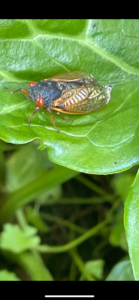 What could be better fodder for a writer than a massive invasion of red-eyed bugs? Perhaps nothing. My friend and former fellow Herald-Citizen columnist Susan Ray texted me in early May, shortly before billions of cicadas all over the Southeast were set to emerge from their thirteen-year-long underground nap. “It’s times like this I almost wish I hadn’t retired from column-writing,” she said. “These cicadas are really going to be something!”
What could be better fodder for a writer than a massive invasion of red-eyed bugs? Perhaps nothing. My friend and former fellow Herald-Citizen columnist Susan Ray texted me in early May, shortly before billions of cicadas all over the Southeast were set to emerge from their thirteen-year-long underground nap. “It’s times like this I almost wish I hadn’t retired from column-writing,” she said. “These cicadas are really going to be something!”
I urged her to write a guest column. She declined. “I give the topic to you,” she said. “As a present.”
I confess I was glad. I remember the last time the periodical cicadas emerged and, yeah, it was something. I lived in an old farmhouse way out in the country, its yard filled with ancient hardwoods. Cicadas blanketed most every tree trunk. Their shells littered the ground and clung to fences and window screens. They flitted about from sunup to sundown, landing on clothes and on bare skin. They got tangled in hair. They sang so deafeningly it was hard to carry on a conversation.
Buster, my big goofy yellow Lab who would eat anything (including, once, a sandwich shrink-wrapped in plastic and, another time, my three-year-old nephew’s mitten), went wild with excitement. He consumed hundreds of cicadas every day, catching them on the fly and swallowing them whole. I called the vet to see if I should be concerned. “If it was any dog but Buster, I might say yes,” Dr. Boyd told me, “but I don’t think you need to worry.”
So I didn’t. And Buster survived the invasion with no ill effects.
I awaited the arrival of this year’s cicadas with eagerness. I dug into my stash of notebooks—all writers have a stash of notebooks—and found one with cartoon ladybugs and butterflies and bumblebees and adorning the cover. Perfect. I planned to keep a detailed, daily cicada journal for this momentous occasion. Because who knows? At my advanced age, I might not be around to see another one.
Periodical cicadas emerge once underground temperatures reach 64 degrees. They shed their shells and, within minutes, their wings become functional. Males begin singing (at volumes as high as 100 decibels, equal to the sound of a jackhammer) to attract girlfriends. It works. After mating, females lay eggs on branch tips of woody shrubs and hardwood trees. In just a few weeks, the adult cicadas die and become fertilizer. Eggs hatch in early August and the babies fall to the ground, where they burrow down at least a foot and survive on the sap of tree roots for the next thirteen years.
Then the story begins again. If that’s not a miracle, I don’t know what is.
The downside is that, where I live now, this miracle was hardly noticeable. I don’t know why. There are far more trees than people in my neighborhood. “Golf course” lawns are not the norm, so there’s likely not much fertilizer or pesticide on the grass. But though I was outside a lot and had my windows open almost all the time, I heard only faint cicada music from mid-May to mid-June, even when I wore my hearing aids. I spotted some cicadas flitting about, but certainly not thousands or millions. Sadly, I wrote on only three pages of my insect journal.
Those pages mostly recount what my “in town” friends, including Susan Ray, experienced and reported. Cicadas blanketed tree trunks. Their shells littered the ground and clung to fences and window screens. They flitted about from sunup to sundown, landing on people’s clothes and bare skin and becoming tangled in their hair. They sang so deafeningly that folks could scarcely carry on conversations.
So I did get a cicada column after all, though not the one I’d planned. I’m just glad that goofy old Buster wasn’t around to experience this year’s emergence. He have been sorely disappointed.
(June 22, 2024)